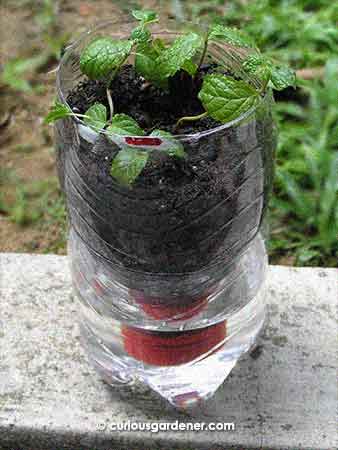I really dislike the haze that has been blowing in over the past weeks.
Firstly, it’s deprived me of gardening when the levels have been too high on weekends (hands up, those who’ve been feeling like they’re choking on the lousy air quality these last few days).
Secondly, the plants are suffering from the hot, dry air that’s been sucking the moisture out of everything.
We all know that fruit-bearing plants and veggies need a good quantity of water to be healthy and productive. I know that I don’t always provide enough water to my plants because I’m not always around to provide that liquid to them. Well, I don’t really want to grow plants that need too much attention, which means that I have to choose hardy veggies, and I need to find and develop systems that are self-sustaining.
The first solution people would suggest would be to install some sort of watering system. I’ve seen different ones online where you can lay out a drip watering system (lots of tubes attached to a tap on a timer), or use an aquaponics system (too much water, and too complicated for a newbie like me), or use self-watering containers.
Video from Growing Your Greens: setting up a drip irrigation system
I’ve dabbled with self-watering containers (SWCs) in the past, using recycled PET bottles to pretty good effect. In fact, there are many varieties of SWCs made from different recycled containers that look pretty interesting, particularly the vertical, stacked ones.
Video from Willem Van Cotthem: bottle tower gardens
There are also contraptions called ollas (pronounced “o-YA”s) – unglazed ceramic pots that you bury up to their necks at the base of plants – that allow water to seep slowly through their porous walls and into the soil to provide water to the plants. They are apparently an old invention brought to the Americas by the Spanish in colonial times. The modern version of these are wetpots, which are connected to a water reservoir via a system of tubes – but having to set up the connections doesn’t particularly excite me because I think it’s complicated and has too much potential to get damaged (we have inquisitive dogs that run amok at times). However, it’s a thought.
Video from Rob Bob: Wetpot irrigation
In fact, when you start looking into all these options, your mind may get boggled – mostly because people love to experiment, and have come up with countless interesting designs of varying degrees of complexity. They’re fun though. I may decide to try some of those methods out myself, but right now, I want something that’s effective and not too complex.
This is why I’ve been looking into concepts of permaculture. What catches my imagination is the idea of creating a food forest. This doesn’t necessarily mean a shaded, overgrown place, but growing a mixture of plants that co-exist and support each other as nature intended, and with minimal to nil interference from people. I’ve heard reports from those who understand how to do this that they only need to work in their gardens for a couple of hours each week once the permaculture systems are established – which is the amount of time I tend to have these days.
Video of A Farm for the Future (go directly to 32:50 if you don’t want to watch the entire film)
or click here to go there directly on Youtube.
Okay, so there are a lot of options out there, and we need to find the solutions that suit our individual gardens. I’m hoping that I will find a permaculture solution, but I’m still on my journey, and I hope it’s not too drawn out because something has to be done to help the plants soon.
© 2014 curiousgardener.com All rights reserved.

